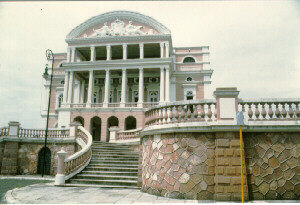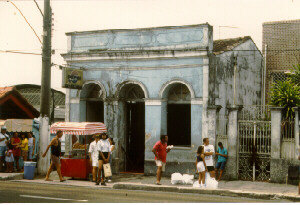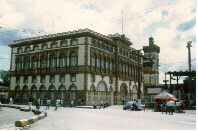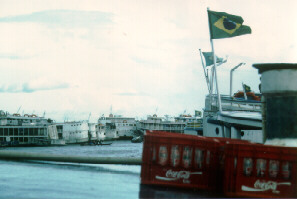About
Manaus
Related Links
|
Manaus
 Manaus
is Amazônia's largest city – it has over a million
people, and is a busy river port which services ships
from all over the world (they arrive by ocean, then sail
upriver to Manaus). The city is located near the meeting
of the Solimões and Rio Negro rivers – 1,500 km
from the Atlantic coast. Manaus
is Amazônia's largest city – it has over a million
people, and is a busy river port which services ships
from all over the world (they arrive by ocean, then sail
upriver to Manaus). The city is located near the meeting
of the Solimões and Rio Negro rivers – 1,500 km
from the Atlantic coast.
Manaus is a modern city with every convenience, luxury
and problem that the 20th Century has to offer – but
outside it is surrounded by the huge Amazon rainforest.
It just takes a short boatride to deliver you into the
middle of wild and remote jungle. There are few roads
going out of the city, so the best way to get into and
out of the city by boat or by plane.
Some important points about the city are:
- It was the centre of the Amazon rubber boom
between 1870 and 1912. The rubber boom
transformed this formerly remote Amazon port into
a modern European-style city.
- The "meeting
of the waters" is one of the most
popular tourist attractions. It is where the
black waters of the Rio Negro meet with the
white/brown waters of the Solimões (Amazon), and
both rivers flow side by side for 20km. The
waters where the rivers meet are rich in
nutrients, attracting many fish and river
dolphins.
- Manaus is the capital of Amazonas – Brazil's
biggest (but one of the least populated) states.
 Manaus was originally the home
of the Manau Indians. The first European settlement was
established in 1669 with the building of a small fort
called São Jose da Barra. This settlement remained very
remote and little known until the rubber boom shot it to
worldwide prominence in the 19th century. By the end of
the 19th century it was a city with over 20,000 people,
it had an extravagant European-style opera house, smart
buildings and restaurants, paved roads, electric trams,
more than 300 telephone subscribers, and a port from
where shipments of rubber were exported while incoming
ships arrived carrying beautiful women and rich bankers
from the United States and Europe. Manaus was originally the home
of the Manau Indians. The first European settlement was
established in 1669 with the building of a small fort
called São Jose da Barra. This settlement remained very
remote and little known until the rubber boom shot it to
worldwide prominence in the 19th century. By the end of
the 19th century it was a city with over 20,000 people,
it had an extravagant European-style opera house, smart
buildings and restaurants, paved roads, electric trams,
more than 300 telephone subscribers, and a port from
where shipments of rubber were exported while incoming
ships arrived carrying beautiful women and rich bankers
from the United States and Europe.
By 1912, the city had swelled to over 50,000 people as
more workers flocked to the city, fleeing droughts and
shortages in Brazil's north-east. They all hoped to make
their fortunes from the Rubber Boom. But unfortunately,
few workers ever managed to make any money – they
were poor and uneducated, and they were easily cheated
out of their earnings by the owners of the companies. The
owners became destitute themselves, and lost their money
when the rubber boom crashed.
Manaus has had lots of "booms" and
"busts", including another rubber boom during
World War II. The second rubber boom was when Malaysia
was occupied by the Japanese army, cutting the Allies off
from the Malaysian rubber plantations. The Brazilian
government ma d Manaus was made a duty-free port in 1967
in an effort to attract settlers from other parts of
Brazil and to develop the area. Duty-free status means
that imported goods in Manaus can be purchased much more
cheaply than in other parts of Brazil because they are
free from expensive taxes. Foreign companies are also
able to establish factories and operate tax-free for a
number of years. Major local industries include
shipbuilding, oil refining and chemicals production, and
electronics manufacture. Other exports include ornamental
fish taken from the Rio Negro (did you ever wonder where
the fish in your aquarium came from?). In recent years,
tourism has also become significant.
Like most other areas in Amazônia, Manaus is hot and
humid – with an average rainfall of over two metres.
There is no summer or winter – just a wet and a dry
season. The wet season lasts from January to June, and a
brief but heavy shower of rain is almost guaranteed every
day. Temperatures range from 23°C to 30°C. The dry
season lasts from July to December, and temperatures
range from 26°C to 37°C.
The people of Manaus are a broad mixture. While most
of the Indian settlements around Manaus were obliterated
by European settlers centuries ago, their descendents
live on in the mixed-blood caboclos. Caboclos are of
mixed race, decended from the European settlers, Indians,
and African slaves who have all inhabited Amazônia since
colonial days. Several of the people that I ran into had
very strong Indian features. There is some risk of crime
in Manaus, but overall the people are very friendly and
helpful.
Most of the people are poor by New Zealand standards,
and don't have fancy houses. It is much more common for
people in the cities to live in big apartment blocks.
However, the people here are much better off than
Brazil's impoverished north-east. Curiously, most
Brazilians like to have new cars, so save for many years
until they can afford to buy one. There are no
used-imported Japanese cars like in New Zealand, but
there are many new Volkwagen Golfs, Fiats, Renaults,
Chevrolet (Holden) Vectras being driven on the roads.
Manaus has its own favela (shantytown), but it isn't as
big as others elsewhere in Brazil.
Economic measures taken by the Brazilian and State
governments are encouraging people to move to Amazonas
from other places in Brazil.
At first look, Manaus seems a little boring. Most
recent buildings are ugly box-like concrete structures,
which soon look run-down and shabby. But if you take some
time to explore, there are plenty of interesting things
to see and do.
- Mercado Municipal. This is the
public marketplace located near Manaus's docks.
The building is an interesting concrete and cast
iron structure designed and prefabricated in
Europe, and built in 1906 during the height of
the rubber boom. It is a good place to go
shopping – there are lots of stalls selling
local crafts and specialties including exotic
fruits, vegetables, fish, and other foods. Nearby
there are also street stalls selling hammocks,
watches, radios, toys, and other goods.
 British Customs
House (Alfândega). This is another
prefabricated building imported during the rubber
boom. The former customs house was designed and
built in Britain, with the blocks then being
imported and assembled at the entrance to
Manaus's docks. British Customs
House (Alfândega). This is another
prefabricated building imported during the rubber
boom. The former customs house was designed and
built in Britain, with the blocks then being
imported and assembled at the entrance to
Manaus's docks.
- Teatro Amazonas. The famous
Manaus Opera House.
 Floating docks
(Porto Flutuante). The huge changes in
the river during the seasons created problems for
the engineers designing Manaus' docks. The river
rises more than 12 metres during the wet season,
then falls again during the dry season. The
floating docks were considered a technological
marvel when they were installed in 1906 because
they change with the river level, and take
anything from oceanliners to canoes. The docks
are an interesting place to visit because it is a
good place to see riverboats being loaded and
unloaded with huge cargos of exotic goods and
people. Floating docks
(Porto Flutuante). The huge changes in
the river during the seasons created problems for
the engineers designing Manaus' docks. The river
rises more than 12 metres during the wet season,
then falls again during the dry season. The
floating docks were considered a technological
marvel when they were installed in 1906 because
they change with the river level, and take
anything from oceanliners to canoes. The docks
are an interesting place to visit because it is a
good place to see riverboats being loaded and
unloaded with huge cargos of exotic goods and
people.
- Instituto Nacional de Pesquisa da
Amazônia (INPA). This is one of many
science and research centres dedicated to finding
our more about Amazônia's plants, animals, and
environment. INPA is working on many projects
including raising and studying animals such as
monkeys, jacaré, manatees, and river otters.
They are also trying to find out the effects that
logging, hydroelectric dams, and mercury
poisoning from goldmining are having on
Amazônia's environment. Because many of the
animals that INPA is researching are endangered
in the wild, INPA is one of the few places that
you can still get a chance to see them.
- Jungle tours. Many local tour
operators in Manaus offering jungle tours by boat
and canoe into the surrounding rainforest. Other
lodges, such as Ariau Towers,
give you the opportunity to spend several days in
the jungle and include a range of activities and
environmental education. They are all part of
Manaus' growing tourist industry. Jungle lodges
are usually located on the Rio Negro because the
river's acidic waters are unsuitable for the
breeding of mosquitoes – making the
surrounding area (mostly) mosquito-free.
- Hotel Tropical. This is Manaus's
famous palacial hotel, and is popular with
tourists wanting a luxurious place to stay to
recover from their jungle tour. Even if you're
not staying there, the hotel grounds are a
wonderful place to visit because you can get a
close look at jaguars and other animals in the
mini-zoo, view giant Vitória Regia water lilies,
or eat in the hotel's fancy restaurants.
- Meeting of the Waters. This is
where the muddy brown waters of the Solimões
(Amazon) and the black waters of the Rio Negro
rivers meet. [More]
|